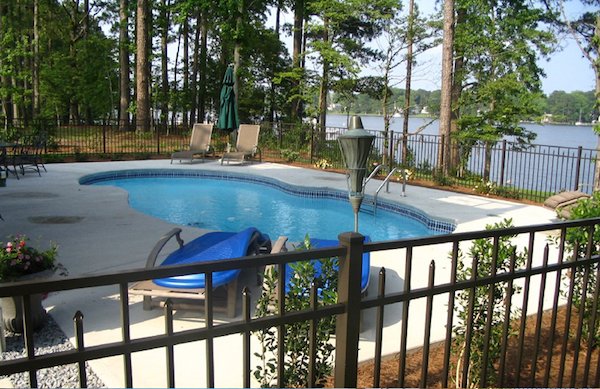We know that your in-ground swimming pool is the main focus of your backyard space. Another important factor is your pool deck; how well it fits into your overall design, and how safe it is for your guests. Pool decks should provide a safe and secure area between your diving boards, ladders, slides, and also provide a nice area for lounging.
Is a pool deck in your future; or you are considering a rehab on the one you do have? We have a few tips for making your choice easier.
Materials matter
Keeping your guest comfort and safety in mind is important. Everyone is typically barefooted on your pool deck, so it’s important that the material you choose won’t become slippery when it gets wet, nor will it absorb too much heat. Everyone should be able to walk safely and securely, even when puddles form from playful pool mates. They should also be able to get to the pool without scorching their feet.
Brick is a nice, DIY-friendly option. It’s durable and you can opt for a variety of colors and installation patterns. Choose paver bricks, as they don’t have holes in them.
Installing brick can be time consuming, as they need to be set individually. Also, dark brick is likely to absorb the heat potentially trapping heat making them harder to walk on.
Pre-cast cement pavers make a fantastic alternative to poured concrete, and are available in many geometrical shapes, including rectangles, octagons and squares.
Installing cement pavers is a do-it-yourself friendly project. They are non-slip and affordable. It’s important to pay attention to the installation. If they aren’t installed correctly over an excavated bed of sand and gravel, they can sink, and therefore create an uneven surface.
Concrete makes a smooth surface from which you can choose a variety of colors besides the familiar gray. Pool decking made of concrete should be poured by a professional, unless you are an expert do-it-yourself type of person with lots of help from others.
It’s easy to maintain and feels good underfoot. It doesn’t absorb much heat when the sun is beating down on it.
Wood feels wonderful underfoot as it’s a smooth surface, but not all types are suitable for a pool deck. A good exterior wood is what you’ll want if you choose a wood deck. Redwood, Teak, or Cedar repel water and insect damage. Wood decking is a good choice if you want to update your existing deck, as it can go directly on top of what you already have.
Since wood is a product of nature, even the most weather-resistant types require a re-application of a sealant for protection.
Surface coatings are another way to spruce up the concrete deck you already have. Surface coatings contain epoxy, or a combination of polymer resins, sand, and cement, which allows them to bond tightly to concrete surfaces. They provide a nice, non-slip surface that is water resistant, and also resistant to pool chemicals.
Tile can be beautiful, but can also be slippery when wet. Choose something with a ‘tooth’ that will prevent your friends and family from sliding into the pool instead of jumping. Since tile is graded on its ‘slip resistance’ play it safe and look for one that is unglazed like terracotta (Saltillo), or vitreous and water-impervious porcelain tile that will withstand frosts and freezes.
A pool deck made with tile can create a seamless indoor-to-outdoor transition, provided the same tile is used.
Stone tile is different from a regular tile. For simple good looks, stone tile is a stunning option. It’s an upscale material available in many natural choices such as limestone, travertine and sandstone. These all blend beautifully when your landscaping has a natural look to it.
Only unglazed stone tile should be used, as glazed tile will be slippery when wet. For comfort on the feet, choose lighter shades that won’t absorb excess heat.
There are other things to consider when choosing your deck beyond the material. Installation and design details are equally as important, whether you are doing it yourself, or having a professional do the work.
Call before you dig. Even if you are only excavating a few inches of ground, call DigSafe (811). This is a free, nationwide service that notifies your utility company so that they can ensure their buried lines won’t be an issue.
Obtain a building permit. Many communities have rules that restrict the installation of a solid surface, such as concrete if the easement is over a utility line. It pays to make a phone call.
If you live in a neighborhood that has an HOA be sure to check the rules and regulations. You do not want to install a finish that doesn’t meet their guidelines. This is another area where it is wise to call.
Don’t neglect the foundation. A beautiful pool deck starts with a good foundation. Pavers, bricks and poured concrete all require excavation with a base of sand or gravel. Tile can be installed over a similar substrate or may require a concrete slab. Wood decks require a floor joist foundation.
Consider the curves. Curves can add into your cost. Even if your project is DIY, it will add to the overall expense of the project.
Factor in the slope. Poured concrete, tile, brick and paver pool decks will all require a slight slope in order for the water to drain properly. The slope should be one-quarter inch per linear foot, and should slope away from the pool to eliminate the run off of dirty water, leaves, and other debris from washing back into the pool.
Add a channel if necessary. If your deck is large, for instance, runs all the way from your house to the pool, you may want to consider adding a channel drain somewhere between the two points to collect water allowing it to drain away to the side or a storm drain.
At Hawaiian Pool Builders, we know that you spent a lot of time considering all of the details for your pool. The details for your deck are just as important, and we are sure we helped you find great ideas for either re-doing your deck, or installing a new one.







